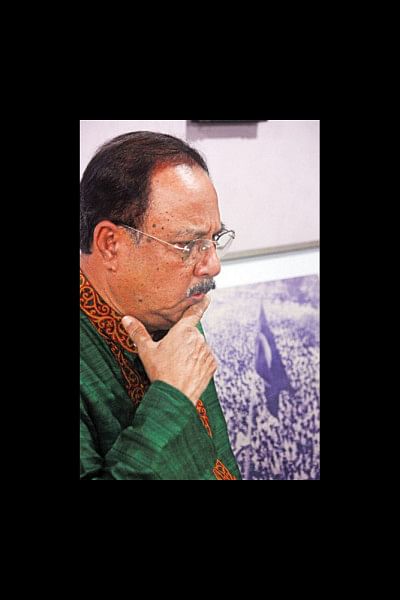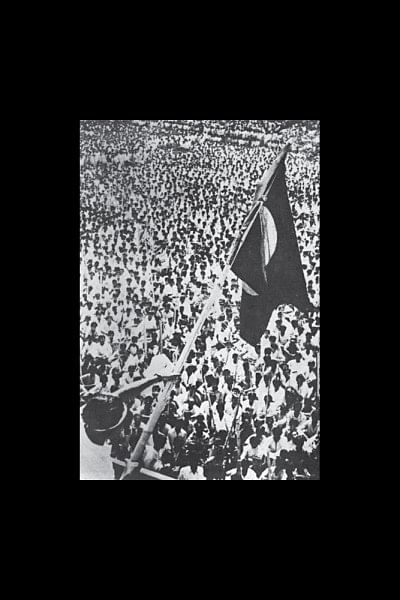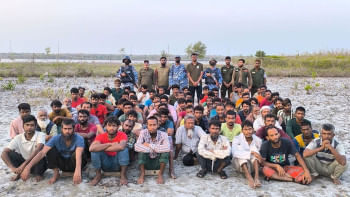The man who raised the flag first

Photo: Kazi Tahsin Agaz Apurbo
"March 2, 1971. There was a huge number of people who came ignoring the curfew in the historic Bot tola of Arts Faculty, Dhaka University, while military helicopters flew over their heads. I was there as well, waiting for history to be made, along with Nur Alam Siddiqui, Shahjahan Siraj and Abdul Kuddus Makhan. We were standing atop the western porch of the Arts Department building with the most valuable possession of that time in my hand - our national flag of independent Bangladesh tied to a bamboo stand," reminisces A S M Abdur Rob, a veteran politician of our country.
"As I hoisted the flag and waved it, I discovered the sea of crowd cheering and belting out slogans of "Joy Bangla", "Bir Bangali Ostro Dhoro, Bangladesh Shadhin Koro" in deliriously happy unison. I don't have words to describe how amazing my experience was; all I can say is that was the best moment of my life," he says, his eyes beginning to tear up.
Rob has many credentials attached to his name - a member of the first opposition party in the Parliament, minister, founder secretary general of the JSD – but, he believes, nothing can beat his identity as a freedom fighter and the man who hoisted the first flag of our independence as the vice president of Dhaka University Student's Union.
Even though the flag was hoisted on March 2, 1971, its making started in 1970.

On the night of June 6, several prominent student leaders, namely Shahjahan Siraj, Kazi Aref Ahmed, Manirul Islam (Marshal Moni), Hasanul Haque Inu, Sharif Nurul Ambia and Swapan Kumar Choudhury, assembled at room number 116 of the then Iqbal Hall (now Shahid Sergeant Jahurul Huq Hall), where Rob lived, in the middle of the night. These young freedom fighters belonged to Shadhin Bangla Biplobi Parishad (Revolutionary Committee for Free Bengal- BLF), a group fighting for liberation. The code name of the team was Nucleus.
During the meeting, they came up with the proposition of designing a flag of the would-be independent state of Bangladesh. After a lot of discussion and based on everyone's consensus, they decided that the base of the flag would be the colour of bottle green, representing the country's greenery with its youthfulness, and the centrepiece of the flag would be blood red, symbolising the sacrifices and bloodshed of freedom fighters and those killed by the occupying force, while a map of the East Pakistan was painted on the flag in gold, against the backdrop of a red, blazing sun.
Once the design was finalised, they rushed to the owner of Apollo cloth shop of Dhaka Khaddar Market right then and managed to buy a piece of the specified cloth. When it was time to stitch the flag, they went to a tailoring shop beside the central office of the Chatra League in the Balaka Building. The location of the shop helped them build a friendship with the owner, so he could not deny assisting this group of young, enthusiastic patriots.
When it came to paint the map inside, Shibnarayan Das, then President of Comilla Chatra League, took the responsibility of painting it in golden. Thus, our first flag was born.
The map was hoisted on the night of June 6 and was later brought down on June 7, following the march past of Joy Bangla Bahini where Rob, as the Chief of the Bahini, handed over the flag to Bangabandhu Sheikh Mujibur Rahman.
Over the next few months, the struggle for liberation took a new turn. Now the student leaders had made it very clear that they had no intention to compromise with the Pakistani occupying force. So on March 1, the student leaders asked everyone to gather at the Bot tola the following day where they were about to announce their subsequent activities.
The rest is history.
Hundreds of students and ordinary people saluted the flag, expressing their solidarity with the movement for liberation, and it became the emblem of our national spirit. During the entire nine months of the Liberation War, our freedom fighters kept this flag very close to their rifles and their heart. "When the martyrs embraced death, their dead bodies too were covered in the flag," Rob adds.
In 1972, renowned Artist Quamrul Hassan was asked to redesign the flag, excluding the map as the contortion of Bangladesh's southern islands made it very difficult to place the map inside the red circle.
"Our national flag was not a result of any one individual's idea and thought process. There were many of us, who spent hours designing an emblem that represents our national spirit. It is sad that we were not asked when changes were made afterwards," says Rob disappointedly. "I still believe that the map should have been there, as it represents the geographical territory of independent Bangla and the struggle behind earning our freedom," he concludes.

 For all latest news, follow The Daily Star's Google News channel.
For all latest news, follow The Daily Star's Google News channel. 



Comments